1966 Chevrolet Impala
This two owner 1966 Chevrolet Impala has been updated from a 250 Six to a 350 V8 and transmission changed from three speed column shift to four on the floor. This three generation classic has been handed down from the grandfather, bought when car was two years old, then from the father with final resting place to the grandson. A repaint was completed in the late 90's. This 20 foot car may not be a number one, but is a fabulous driver. Drives great and looks great! The steering wheel could be replaced and an extra one comes with the car in the event the new owner would like to replace it. Tires have been recently replaced. The rear air shocks is nice to be able to change the cars rake. Over 100 photo's included here to give you a good over view of the car's condition. The extremely low miles is a real plus to the value of this classic. Your welcome to call or text Don with your questions or have all photo's sent via Dropbox for a micro look at every square inch of the car. We look forward to hear from you with your questions. A video has been added so you can listen to the strong sound of the engine. Looks great going down the road does it not? NOTE: If you would like to see all photo from DropBox so a microscopic view can be enjoyed, just call/text with your email address so the link can be sent to you. For those wishing to understand and know more about the 66 4th generation Impala, here some education for you from Wikipedia. Fourth generation (1965–1970)Main article: Chevrolet Impala (fourth generation)Fourth generation | 1965 Chevrolet Impala Sport Coupe | Overview Production| 1964–1970[19] | Model years| 1965–1970 | Assembly- United States: Arlington, Texas, (Arlington Assembly)
- Atlanta, Georgia, (Lakewood Assembly)
- South Gate, California, (South Gate Assembly)
- Flint, Michigan (Flint Assembly)
- Framingham, Massachusetts (Framingham Assembly)
- Janesville, Wisconsin, (Janesville Assembly)
- Norwood, Ohio, (Norwood Assembly)
- St. Louis, Missouri (St. Louis Assembly)
- Sleepy Hollow, New York, (North Tarrytown Assembly)
- Lordstown, Ohio, (Lordstown Assembly)
- Wilmington, Delaware, (Wilmington Assembly)
- Canada: Oshawa, Ontario (Oshawa Car Assembly)
- Sainte-Thérèse, Quebec, (Sainte-Thérèse Assembly)
- Australia[20][21]
| Body and chassis Body style- 2-door convertible
- 2-door coupe
- 2-door hardtop
- 4-door hardtop
- 4-door sedan
- 4-door station wagon
| Layout| FR layout | Platform| B-body | RelatedChevrolet Caprice
Chevrolet Bel Air
Chevrolet Biscayne | Powertrain Engine- 250 cu in (4.1 L) Turbo Thrift I6
- 283 cu in (4.6 L) Turbo Fire V8
- 307 cu in (5.0 L) Turbo Fire V8
- 327 cu in (5.4 L) Turbo Fire V8
- 350 cu in (5.7 L) Turbo Fire V8
- 396 cu in (6.5 L) Turbo-Jet V8
- 400 cu in (6.6 L) Turbo Fire V8
- 409 cu in (6.7 L) Turbo-Jet V8
- 427 cu in (7.0 L) Turbo-Jet V8
- 454 cu in (7.4 L) Turbo-Jet V8
|
Redesigned in 1965, the Impala set an all-time industry annual sales record of more than 1 million units in the United States. All new full-size Chevrolets eschewed the "X" frame for a full-width perimeter frame, a new body that featured curved, frameless side glass (for pillarless models), sharper angled windshield with newly reshaped vent windows, and redesigned full-coil suspension. 1966 Impala SS ConvertibleIn 1965, Chevrolet introduced a new luxury package for the Impala four-door hardtop, called "Caprice" and coded as RPO Z18. Caprices received tufted upholstery, wood grained accents on the dashboard and specialty pulls on the insides of the doors. This "halo" model also featured the "spinner" wheel covers from the Impala SS, with the "SS" logo centers replaced by a Chevrolet "bowtie" emblem. The Super Sport's blackout rear trim strip below the triple taillights was also used, with the "Impala SS" emblem replaced by a large "Caprice by Chevrolet" badge. The Impala block lettering on each front fender was replaced with "Caprice" script. The Caprice package was reintroduced as the Chevrolet Caprice Custom in 1966, taking the top position in the full-size Chevrolet lineup. Engine choices included the inline six-cylinder as well as the small-block and big-block V8s. A new three-range Turbo Hydra-Matic automatic transmission was optional for 396 cu in (6.5 L) V8. The old 409 cu in (6.7 L) "W" engine was discontinued early in the 1965 model year, so early-production 1965s got the 409, as well as 1/10 of 1% had the 396 CID big-block. Other later-built cars had the 396 cu in (6.5 L) as the big-block option. Two-speed Powerglide, as well as 3- and 4-speed manual transmissions were available. As with previous years, Impalas featured more chrome trim inside and out, with pleated tufted upholstery and door panels. The Impala would be the #2-selling convertible in the US in 1966, with 38,000 sold; it was beaten by the Mustang by almost 2:1.[22] 1966 saw a pair of enlarged big-block V8s featuring 427 cu in (7.0 L). The RPO L36 was rated at 385 hp (287 kW), the L72 at 425 hp (317 kW). The L72 was only available with a manual transmission. The 1967 model was redesigned with enhanced Coke bottle styling that featured Corvette-inspired front and rear fender bulges. The curves were the most pronounced with the 1967–1968 models. In keeping with federal regulations, safety features were built into Impalas during the 1967 and 1968 model years, including a fully collapsible energy-absorbing steering column, side marker lights, and shoulder belts for closed models. The L72 engine was not available in 1967, but a L36 Turbo-Jet V8 was optional. 1968 Impala Sport CoupeThe 1968 model was facelifted with a new front end. The new rear bumper housed triple "horseshoe" shaped taillights. 1968 also saw a new Impala model, the Custom Coupe. This two-door hardtop featured the same formal roofline as the Caprice Coupe. It was successful and would be continued right through 1976. The L72 "427 Turbo-Jet" engine was once again returned to the option list, a solid-lifter V8 rated at 425 hp (317 kW). It would continue to be available for both 1968 and 1969, replaced by the Turbo-Jet 454 for 1970. The 1969 Impala and other full-sized Chevrolets got new slab-sided bodies with a small "upsweep" at the rear quarter window, giving them a more formal appearance. It retained the 119-inch wheelbase from previous models. New front bumpers that wrapped around the grille and horizontal taillights were in the rear bumper. The hardtop Sport Coupe got a new notchback roofline, replacing the "fastback" C-pillar from 1967 to 1968. Ventless front windows were used on all models. Chevrolet had a rudimentary "power vent" system featuring vents in the instrument panel. The ignition switch was moved from the instrument panel to the steering column, and when the key was removed, the steering wheel and shift lever were locked. The 1969 model year Impala production topped Caprice production by 611,000 units. Impala station wagons were renamed Kingswood, a name which would continue through 1972. The similar 1970 Impala got a minor facelift featuring a more conventional under the grille bumper replacing the wrap-around unit used in 1969 along with new triple vertical taillights in the rear bumper. Canadian buyers got the choice of a lower priced companion to the Impala Sport Coupe, the Bel Air Sport Coupe, which used the same body but featured Bel Air trim. ExportsRight hand drive cars were manufactured in Canada for export to countries such as Australia, New Zealand, the United Kingdom, etc., until 1969. They used a version of the 1965 Impala dash panel — without provision for a radio and installed in a dashboard moulding made of fibreglass, not metal — until 1969. Radios (centrally mounted) and heaters were locally sourced and wipers parked in the center of the windscreen. Australian models were assembled in Australia from kits, as this lessened tax on the cars. The Australian cars had locally sourced amber flashing rear indicators replacing the clear reversing lenses, as red flashers were banned there. For New Zealand assembly, the bodies were supplied from Canada already welded, painted and trimmed. Impala SS (1961–1969)In a December 17, 1960 press release Chevrolet Motor Division introduced the Impala SS (Super Sport) to the market. The SS badge was to become Chevrolet's signature of performance on many models, though it often has been an appearance package only. The Impala's factory SS package in 1961 was truly a performance package when so equipped from the factory with both the trim and "mandatory" suspension and engine upgrades, beginning with the 348 cu in (5.7 L) V8 engines available with 305 hp (227 kW; 309 PS), 340 hp (254 kW; 345 PS), and 350 hp (261 kW; 355 PS) or the new 409 cu in (6.7 L) V8, which in 1961 was rated at 360 hp (268 kW; 365 PS). Unlike all other years, the 1961 Super Sport package was available on any Impala, including sedans and station wagons (the sales brochure shows a 4-door hardtop Sport Sedan with the SS package). The package also included upgraded tires on station wagon wheels, springs, shocks and special sintered metallic brake linings. Only 142 1961 Impala Super Sports came from the factory with the 409. In addition to the factory-installed SS package, Chevrolet dealers could add SS trim to any standard Impala without the "mandatory" performance upgrades, and a number of '61s were so equipped. Starting for the 1962 model year, the Impala SS was an appearance package limited to hardtop coupe and convertible coupe models, available with all engines in the Impala series starting with the base 235 cu in (3.9 L), 135 hp (101 kW; 137 PS) inline-6 through 1967, though the big-block engines and heavy-duty parts could still be ordered. From 1967 to 1969, an additional model, the SS427, was available. 1964 Impala Super Sport Coupe 1965 Chevrolet Impala Super Sport CoupeThe Super Sport was known as Regular Production Option (RPO) Z03, from 1962 to 1963, and again in 1968. From 1964 through 1967, the Super Sport was a separate model, with its own VIN prefix (for V8 models, 168 versus the 164 for the regular Impala). Super Sports from 1962 to 1964 came with engine-turned aluminum trim, which was replaced by a "blackout" trim strip in 1965 which ran under the taillights. 1965 Super Sport exteriors differed only slightly from regular Impalas. Rocker panel trim was deleted. "Super Sport" scripts replaced the "Impala" fender badges. The new center console housed a rally-type electric clock, and full instrumentation now included a vacuum gauge. A total of 243,114 Impala SS coupes and convertibles were built for 1965. The 1966 Impala SS was facelifted with a revised grille and new rectangular taillights that replaced the triple round units. A chrome beltline strip shared with regular Impalas was added in response to complaints about door dings on the clean-lined 1965s. Inside were new "Strato-bucket" front seats with thinner and higher seat backs, and a center console with an optional gauge package available. Sales of the 1966 Impala SS dropped by more than 50% to around 117,000 units; this was mainly due to the sport/performance car market switching from full-sized models to intermediates (including Chevrolet's own Chevelle SS396 and Pontiac GTO), along with the emerging market for the even smaller pony car market created by the Ford Mustang in 1964 that Chevrolet would respond to with the Camaro for 1967. The 1967 Impala SS was less decorated than other Impalas; Super Sports had black grille accents and black-accented body-side and rear fender moldings. Lesser models leaned more toward brightwork inside and out. Buyers could choose either vinyl bucket seats with a center console, or a Strato-Bench seat with a fold-down center armrest. Standard wheel covers were the same as the optional full covers on other big Chevrolets, but the centers featured the "SS" logo surrounded by tri-color ring of red, white and blue. "Chevrolet" and "Impala" callouts on the body were all replaced by "Impala SS" badges. Of the 76,055 Impala SS models built, just 2,124 were ordered with RPO Z24, a special performance package that included RPO F41 heavy-duty suspension and other performance features, RPO L36 (385 hp (287 kW; 390 PS)) Turbo-Jet 427 cu in (7.0 L) V8, as well as a special trim package that replaced the "Impala SS" badges with large "SS427" emblems on the front grille and rear trim. None of these cars had the name "Impala" anywhere on the body or interior, and Chevrolet often marketed them as the "Chevrolet SS427," sans the "Impala" name. The Z24 package also included a special hood with fake chrome-plated intake. Only about 400 Super Sports had a six-cylinder engine from 1967 to 1968, 390 hp (291 kW; 395 PS) in 1969, or L72 (425 hp (317 kW; 431 PS)) from 1968 to 1969. Special SS427 badging, inside and out, was the rule, but few were sold, since muscle car enthusiasts were seeking big-block intermediates, such as the Chevelle SS396 and Plymouth Road Runner. In 1968 as Caprice sales escalated, those of the Impala Super Sport suffered a decline. Much of this drop in sales was no doubt due to the availability of big-block engines in the mid-sized (and lighter) Chevelle, and even Novas could be special-ordered with the 396 engine with the new-for-1968 body. No longer a separate series, the Super Sport was a mere $179 option package (Regular Production Option Z03) for the two Impala coupes and the convertible. Only 38,210 Impalas were so-equipped, including 1,778 with the Z24 package, which was carried over from 1967. In 1968 only, SS427s could be ordered without the Z03 SS package, which meant SS427 equipment but no bucket seats, SS door panels, or center console. The Z03 Impala SS could be identified by "Impala Super Sport" badges on the front grille, rear fenders and trunk lid. Z24-optioned cars included "SS427" emblems to replace the "Impala Super Sport" badges, a special layered "pancake" hood, and three "gills" mounted on the front fender aft of the wheel well à la Corvette Stingray. In 1969, the Impala SS was available only as the Z24 (SS427), coming exclusively with a 427 cu in (7.0 L) V8 of 335 hp (250 kW; 340 PS), 390 hp (291 kW; 395 PS), or 425 hp (317 kW; 431 PS). This was the final year for the Impala SS until 1994. Unlike the previous two years, the 1969s finally got "Impala" script on the front fenders and interior. The 1969 Impala SS had no distinctive SS badging inside the car except for an "SS" logo the steering wheel (again, there was no Z03 offered that year). Like the 1968s, the Z24 could be ordered on the Impala convertible, Sport Coupe, or Custom Coupe. 1969 was the last year that the Impala SS was offered with the Z24 package, but the only year in which front disc brakes and 15-inch (380 mm) wheels were standard; that made the 1969 SS427 mechanically better than the previous versions in standard form. Although sales of 1969 Z24-optioned Impalas increased to approximately 2,455 units from the 1,778 Z03-optioned units of 1968, and high-powered big-block V8 engines continued to be available, there would be no Impala SS for 1970. The 427 was also replaced on the engine offerings list by a new Turbo-Jet 454 producing 390 hp (291 kW; 395 PS) The 1965–1970 GM B platform is the fourth best selling automobile platform in history after the Volkswagen Beetle, Ford Model T and the Lada Riva. |
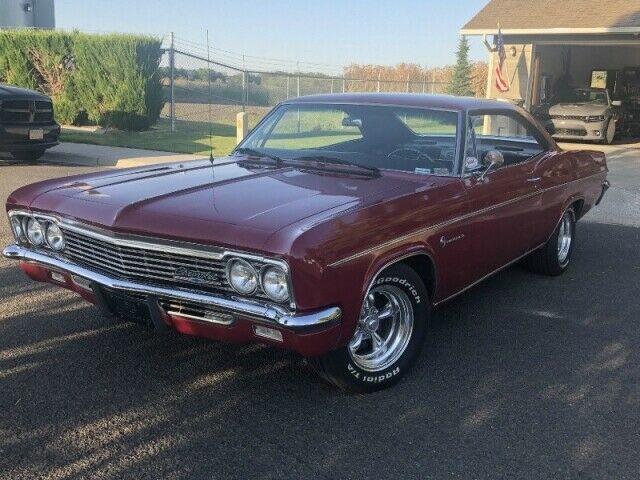
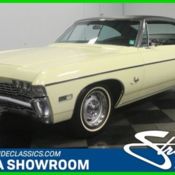 1968 Chevrolet Impala Hardtop 1968 Used Automatic
1968 Chevrolet Impala Hardtop 1968 Used Automatic
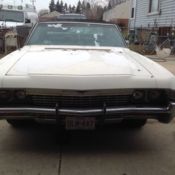 1968 Chevrolet Impala Custom Coupe 1968 Custom barn find project
1968 Chevrolet Impala Custom Coupe 1968 Custom barn find project
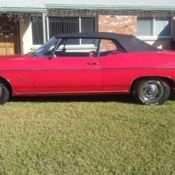 1968 chevrolet impala ss with 427
1968 chevrolet impala ss with 427
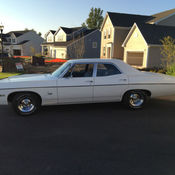 1968 Chevrolet Impala **WOW**
1968 Chevrolet Impala **WOW**
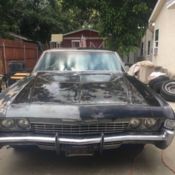 1968 396 chevrolet impala
1968 396 chevrolet impala
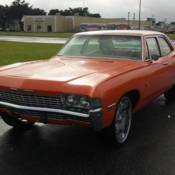 1968 Chevrolet Impala 350
1968 Chevrolet Impala 350